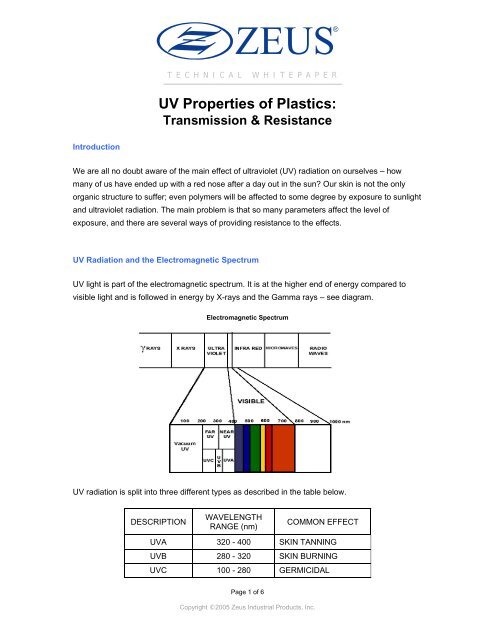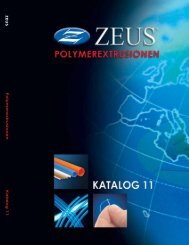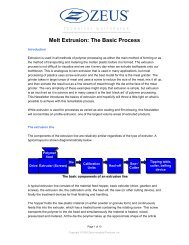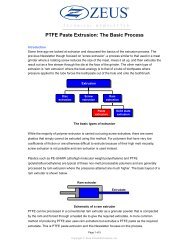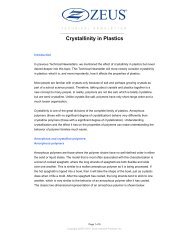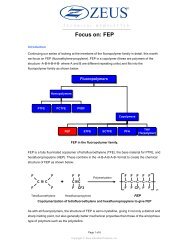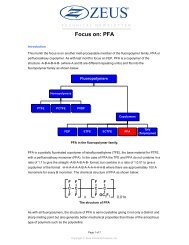UV Properties of Plastics: - Zeus Industrial Products, Inc.
UV Properties of Plastics: - Zeus Industrial Products, Inc.
UV Properties of Plastics: - Zeus Industrial Products, Inc.
Create successful ePaper yourself
Turn your PDF publications into a flip-book with our unique Google optimized e-Paper software.
Introduction<br />
TECHNICAL WHITEPAPER<br />
<strong>UV</strong> <strong>Properties</strong> <strong>of</strong> <strong>Plastics</strong>:<br />
Transmission & Resistance<br />
We are all no doubt aware <strong>of</strong> the main effect <strong>of</strong> ultraviolet (<strong>UV</strong>) radiation on ourselves – how<br />
many <strong>of</strong> us have ended up with a red nose after a day out in the sun? Our skin is not the only<br />
organic structure to suffer; even polymers will be affected to some degree by exposure to sunlight<br />
and ultraviolet radiation. The main problem is that so many parameters affect the level <strong>of</strong><br />
exposure, and there are several ways <strong>of</strong> providing resistance to the effects.<br />
<strong>UV</strong> Radiation and the Electromagnetic Spectrum<br />
<strong>UV</strong> light is part <strong>of</strong> the electromagnetic spectrum. It is at the higher end <strong>of</strong> energy compared to<br />
visible light and is followed in energy by X-rays and the Gamma rays – see diagram.<br />
Electromagnetic Spectrum<br />
<strong>UV</strong> radiation is split into three different types as described in the table below.<br />
DESCRIPTION<br />
WAVELENGTH<br />
RANGE (nm)<br />
Page 1 <strong>of</strong> 6<br />
Copyright ©2005 <strong>Zeus</strong> <strong>Industrial</strong> <strong>Products</strong>, <strong>Inc</strong>.<br />
COMMON EFFECT<br />
<strong>UV</strong>A 320 - 400 SKIN TANNING<br />
<strong>UV</strong>B 280 - 320 SKIN BURNING<br />
<strong>UV</strong>C 100 - 280 GERMICIDAL
One <strong>of</strong> the main problems when considering the effect <strong>of</strong> <strong>UV</strong> rays on polymers is the intensity<br />
related to: stratospheric ozone, clouds, altitude, the position <strong>of</strong> the sun height (time <strong>of</strong> day and<br />
time <strong>of</strong> year), and reflection. The complexity <strong>of</strong> the effects can be seen in a global plot <strong>of</strong> <strong>UV</strong><br />
levels – dark green being the highest:<br />
It is also important to remember that actual ambient temperature and humidity will accelerate any<br />
effect <strong>of</strong> the intensity level.<br />
The Main Effects on Polymers Exposed to <strong>UV</strong><br />
All types <strong>of</strong> <strong>UV</strong> can cause a photochemical effect within the polymer structure, which can be<br />
either a benefit or lead to degradation <strong>of</strong> some sort to the material. Note that compared to our<br />
skin, the higher energy <strong>UV</strong>C is more likely to affect plastics.<br />
Degradation.<br />
The main visible effects are a chalky appearance and a color shift. The component surface may<br />
also become brittle. I can vouch for these effects as found in my children’s red polypropylene (PP)<br />
monkey bars. After a few years in the garden the extruded pipes retained their full color, while the<br />
injection molded clamp parts became white and cracked. Other components likely to be affected<br />
by solar exposure include stadium seats, outdoor furniture, greenhouse films, window frames and<br />
automotive parts.<br />
Some plastics have been exposed to much harsher radiation levels than we experience on earth.<br />
Components in the Hubble Space Telescope (HST) and the International Space Station (ISS)<br />
require plastics that can survive the demands <strong>of</strong> outer space. Fluoropolymers such as FEP and<br />
polyimides like Kapton are plastics which have been successfully used for the HST and ISS.<br />
Page 2 <strong>of</strong> 6<br />
Copyright ©2005 <strong>Zeus</strong> <strong>Industrial</strong> <strong>Products</strong>, <strong>Inc</strong>.
The above effects are predominantly in the surface layer <strong>of</strong> the material and are unlikely to<br />
extend to depths above 0.5mm into the structure. However, stress concentrations caused by the<br />
highly brittle nature <strong>of</strong> some commodity plastics may well lead to a complete failure <strong>of</strong> the<br />
component.<br />
Benefits.<br />
Many <strong>of</strong> us will be using <strong>of</strong> the main benefits from <strong>UV</strong> radiation <strong>of</strong> protective polymeric coatings,<br />
such as polyurethane-acrylates, on exterior automobile components, which have been cured by<br />
<strong>UV</strong>. A more local benefit for many people will be the <strong>UV</strong> radiation in counter top purifiers and<br />
water coolers which is <strong>of</strong>ten assisted by the good transmission properties <strong>of</strong> FEP (Fluorinated<br />
Ethylene Propylene) tubing and its ability not to degrade. Melt-processable FEP is also used as a<br />
protective coating on <strong>UV</strong> lamps for electronic fly killers, where the coating allows for excellent<br />
transmission (only around 4% loss for a 0.25mm film). There are also many applications for <strong>UV</strong>,<br />
including curing <strong>of</strong> inks on plastic substrates, and <strong>UV</strong>C radiation for sterilization <strong>of</strong> components.<br />
Interaction <strong>of</strong> <strong>UV</strong> Radiation and <strong>Plastics</strong><br />
<strong>UV</strong> energy absorbed by plastics can excite photons, which then create free radicals. While many<br />
pure plastics cannot absorb <strong>UV</strong> radiation, the presence <strong>of</strong> catalyst residues and other impurities<br />
will <strong>of</strong>ten act as free radical receptors, and degradation occurs. It only takes a very small amount<br />
<strong>of</strong> impurity for the degradation to occur, e.g. trace parts per billion values <strong>of</strong> sodium in<br />
polycarbonate (PC) will initiate color instability. In the presence <strong>of</strong> oxygen, the free radicals form<br />
oxygen hydroperoxides that can break the double bonds <strong>of</strong> the backbone chain leading to a brittle<br />
structure. This process is <strong>of</strong>ten called photo-oxidation. However, in the absence <strong>of</strong> oxygen there<br />
will still be degradation due to the cross-linking process, which is the effect for plastics used for<br />
the Hubble Space Telescope and International Space Station.<br />
Unmodified types <strong>of</strong> plastics that are regarded as having unacceptable resistance to <strong>UV</strong> are POM<br />
(Acetal), PC, ABS and PA6/6. Other plastics such as PET, PP, HDPE, PA12, PA11, PA6, PES,<br />
PPO, PBT and PPO are regarded as fair. Note that a PC/ABS alloy is graded as fair. Good<br />
resistance to ultraviolet rays can be achieved from polymers extruded by <strong>Zeus</strong> such as PTFE,<br />
PVDF, FEP, and PEEK TM .<br />
PTFE has particularly good <strong>UV</strong> resistance because it has the very strong carbon-fluorine (C-F)<br />
bond (almost 30% higher than the carbon-hydrogen (C-H) bond), which is the common side bond<br />
that surrounds the carbon (C-C) backbone in the helix and protects it. There is also the fact that<br />
most fluoropolymers do not have the light absorbing chromophore impurities in their structure that<br />
can act as an initiator for photo-oxidation. The only plastics found with excellent resistance are<br />
Page 3 <strong>of</strong> 6<br />
Copyright ©2005 <strong>Zeus</strong> <strong>Industrial</strong> <strong>Products</strong>, <strong>Inc</strong>.
the imides. Polyimide (PI) as used in the Hubble Space Telescope, and polyetherimide (PEI).<br />
One useful interaction <strong>of</strong> <strong>UV</strong> and plastics can be as fluorescent whitening agents (FWA). In<br />
natural light many polymer products can appear to have a yellow appearance. By including a<br />
special additive, the <strong>UV</strong> light absorbed is then emitted in the 400-500 nm range (the blue region<br />
<strong>of</strong> visible light), which causes it to appear whiter. Compared to other additives they only need to<br />
be added at small levels, typically 0.01 – 0.05 % by weight.<br />
How to Avoid <strong>UV</strong> Degradation<br />
There are several ways <strong>of</strong> avoiding <strong>UV</strong> degradation in plastics – by using stabilizers, absorbers or<br />
blockers. For many outdoor applications, the simple addition <strong>of</strong> carbon black at around a 2% level,<br />
will provide the protection for the structure by the blocking process. Other pigments such as<br />
titanium dioxide can also be effective. Organic compounds such as benzophenones and<br />
benzotriazoles are typical absorbers which selectively absorb the <strong>UV</strong> and re-emit at a less<br />
harmful wavelength, mainly as heat. The benzotriazole type is good, as it has a low color and can<br />
be used at low dose rates below 0.5%.<br />
The other main mechanism for protection is to add a stabilizer, the most common being a HALS<br />
(Hindered Amine Light Stabilizer). These absorb the excited groups and prevent the chemical<br />
reaction <strong>of</strong> the radicals.<br />
In practice, the various types <strong>of</strong> additives used are in combinations, or are compounded into the<br />
original polymer to be produced as a special grade for <strong>UV</strong> protection. It may be attractive to add<br />
antioxidants to some plastics to avoid photo-oxidation, but care must be taken that the antioxidant<br />
chosen does not act as an <strong>UV</strong> absorbent, which will actually enhance the degradation process.<br />
Testing <strong>of</strong> Components<br />
The weathering <strong>of</strong> components is most <strong>of</strong>ten associated with outdoor products, but there can also<br />
be <strong>UV</strong> radiation from indoor strip fluorescent lighting where the covers should be resistant to<br />
degradation and adverse coloring. Accelerated aging is a common technique for assessing longterm<br />
damage, with the product being exposed to artificial light from various sources. The<br />
exposure <strong>of</strong>ten takes place at an elevated temperature and can be cycled with periods <strong>of</strong> high<br />
humidity.<br />
There are several standards which regulate the type and levels <strong>of</strong> illumination, e.g. ASTM D 2565<br />
(Standard Practice for Xenon Arc Exposure <strong>of</strong> <strong>Plastics</strong> Intended for Outdoor Applications).<br />
Page 4 <strong>of</strong> 6<br />
Copyright ©2005 <strong>Zeus</strong> <strong>Industrial</strong> <strong>Products</strong>, <strong>Inc</strong>.
Others are, with abridged descriptions, ASTM D 4329 (Fluorescent lamp), ASTM D 4459 (same<br />
as 2565 but for Indoor Applications), SAE J1960 (automotive exteriors with Xenon arc), ISO<br />
4892-2 (Xenon arc) and ISO 4892-3 (Fluorescent). However, none <strong>of</strong> the standards give a<br />
required standard for the properties <strong>of</strong> the product at the end <strong>of</strong> the exposure period.<br />
Several major users derive their own criteria. An example is the Weathering <strong>of</strong> Plastic Pipes<br />
(Report TR18/99) by the Plastic Pipe Institute, which warns <strong>of</strong> the large differences in<br />
environment for different locations in the USA. Another is for plastic lumber where the hardness<br />
<strong>of</strong> the outer skin must not have changed by more than 10% after 500 hours <strong>of</strong> exposure.<br />
In the list above there are standards for exposure in indoor applications. This is very relevant for<br />
plastics used in fluorescent light casings, where the illuminant spectrum contains <strong>UV</strong> radiation.<br />
There will be an obvious effect <strong>of</strong> discoloration if a non-stabilized polymer is used.<br />
Summary<br />
If a product is to be exposed to direct sunlight then the designer or engineer must specify suitable<br />
testing standards and make sure the plastic has appropriate formulation to maintain the desired<br />
long-term properties. <strong>Inc</strong>luding additives in the polymer melt process may provide protection, or if<br />
volumes are sufficiently high, the additives can be pre-compounded into the resin.<br />
Fluoropolymers such as PTFE, FEP, PFA and other resins extruded at <strong>Zeus</strong> <strong>of</strong>fer good<br />
resistance to <strong>UV</strong> radiation. For more information concerning materials that may be suitable for<br />
your specific application, contact your <strong>Zeus</strong> Technical Account Manager for immediate assistance<br />
or visit our website at www.zeusinc.com for additional data.<br />
Page 5 <strong>of</strong> 6<br />
Copyright ©2005 <strong>Zeus</strong> <strong>Industrial</strong> <strong>Products</strong>, <strong>Inc</strong>.
How <strong>Zeus</strong> Can Help<br />
With a technical inside and outside sales force backed up with engineering and polymer experts,<br />
<strong>Zeus</strong> is prepared to assist in material selection and can provide product samples for evaluation. A<br />
dedicated R&D department staffed with PHD Polymer chemists and backed with the support <strong>of</strong> a<br />
world-class analytical lab allows <strong>Zeus</strong> an unparalleled position in polymer development and<br />
customization.<br />
Since 1966 <strong>Zeus</strong> has been built upon the core technology <strong>of</strong> precision extrusion <strong>of</strong> high<br />
temperature plastics. Today, with a broad portfolio <strong>of</strong> engineered resins and secondary<br />
operations, <strong>Zeus</strong> can provide turnkey solutions for development and high-volume supply<br />
requirements.<br />
Contact Us<br />
Visit http://www.zeusinc.com for more information about our products and capabilities, or give<br />
us a call at (toll-free) 1-866-272-4118<br />
Page 6 <strong>of</strong> 6<br />
Copyright ©2005 <strong>Zeus</strong> <strong>Industrial</strong> <strong>Products</strong>, <strong>Inc</strong>.


